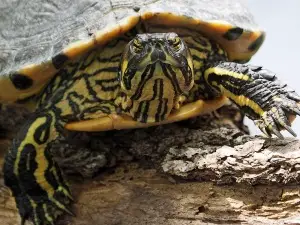
Your yellow-bellied turtle suddenly refusing food will leave you confused and wondering what the potential reasons for this behavior are.
A loss of appetite in humans is quite concerning but is this the same for turtles?
This article looks into why your yellow-bellied turtle is not eating
Table of Contents
Why is my yellow-bellied turtle not eating?
Appetite loss from time to time can happen in turtles and there are a variety of reasons why this happens in yellow-bellied turtles
Here are reasons why your yellow-bellied turtle is not eating:
The animal’s age:
If your yellow-bellied slider ate often as a youngster, and is now eating less and less as an adult, then what you’re seeing is normal turtle behavior.
The diet of older turtles differs from the diet of younger turtles.
The younger of these animals will eat daily for them to survive and grow, growth is very energy intensive so the youngsters need to eat a lot.
The older yellow-bellied turtles will eat less as they age, these animals can be fed every two to three days
What to do:
If your pet is eating less, but isn’t showing signs of illness or distress, then what you’re seeing is normal and is not out of the ordinary
Feed your pet according to its age and weight and use this guide to see if your pet is eating as much food as it’s supposed to be eating.
Remove the foods that the older turtles haven’t eaten, do this daily, this will promote proper hygiene. Add fresh food to the tank as needed.
The animal is cold:
Another reason why your pet turtle may be refusing to eat may be because the animal is cold.
These animals are cold-blooded, their environment plays a big role in the animal’s body temperature. If the animal’s body temperature is cold this will slow the turtle’s metabolism down and cause it not to want to eat.
The animal’s body will cause it to not want to eat because a slow metabolism doesn’t digest food quickly, if the animal’s food hasn’t been digested then the animals won’t want to eat more food.
What to do:
Increasing your pet’s environmental temperature should get it to eat again.
Do this by maintaining the temperature around 75-85° F (24-29° C) and keeping the basking temperature at about 90-95° F (32-35° C). The temperature of the water should be between 72-77° F (22-25° C).
Illness:
If your pet has suddenly stopped wanting to eat, but it’s environment is correct, and the animal is an adult, then your pet may not want to eat because the animal is sick.
These animals can suffer from a variety of health issues including respiratory infections, parasitic infections, stress, vitamin A deficiency, constipation, and eye problems to name a few, and one of the first signs of a sick turtle is a lack of appetite.
What to do:
There are a variety of illnesses that can cause your pet to have a loss of appetite, the more symptoms the animal shows the easier it will be to diagnose the animal.
That being said, diagnosing the animal at home may take a while, and incorrect home diagnoses are common, so, it’s recommended that you take the animal to the vet for a diagnosis and treatment.
If you enjoyed this article then you may also be interested in other turtle/tortoise related articles. Here are some articles that you may be interested in: Why Is My Turtle’s Tank Water Red?, Why Does My Turtle Run From Me, Why Is My Turtle’s Shell Turning Yellow?, Why Is My Turtle In Its Shell?, Why Is My Turtle Standing Up?, Why Does My Turtle Look Fuzzy?, Why Is My Turtle Poop White?, Why Is My Turtle Poop Red?, Why Is My Turtle Underwater?

